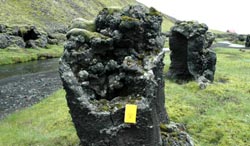Water and lava, but — curiously — no explosion

A lava pillar in Iceland's Skaelingar valley. A new study suggests that these pillars were formed in an unusual interaction where lava and water met on land without exploding. Credit: Tracy Gregg<br>
Rocky pillars dotting Iceland’s Skaelingar valley were projectiles tossed into the fields by warring trolls.
That, at least, is the tale that University at Buffalo geologist Tracy Gregg heard from a tour guide and local hiker when she visited the site on two occasions.
But Gregg and a colleague have a new explanation for the presence of the lava formations — this one also unexpected.
In the Journal of Volcanology and Geothermal Research, she and former UB master’s student Kenneth Christle report that the pillars, hollow and made from basalt, likely formed in a surprising reaction where lava met water without any explosion occurring.
Their findings appeared online Aug. 15 and will be published in a forthcoming print edition of the journal.
“Usually, when lava and water meet in aerial environments, the water instantly flashes to steam,” said Gregg, a UB associate professor of geology. “That’s a volume increase of eight times — boom.”
“Formations like the ones we see in Iceland are common in the ocean under two miles of water, where there’s so much pressure that there’s no explosion,” she said. “They’ve never been described on land before, and it’s important because it tells us that water and lava can come together on land and not explode. This has implications for the way we view volcanic risk.”
Deep-sea basalt pillars form when columns of super-heated water rise between pillows of lava on the ocean floor, cooling the molten rock into hollow, pipe-like minarets. The structures grow taller as lava levels rise, and remain standing even after volcanic eruptions end and lava levels fall again.
Gregg and Christle propose that the same phenomenon sculpted the land-based lava pillars in Iceland.
It happened in the 1780s, when lava from a nearby eruption entered the Skaelingar valley, which Gregg theorizes was covered by a pond or was super-swampy.
She thinks one reason no explosion occurred was because the lava was moving so slowly — centimeters per second — that it was able to react with the water in a “kinder, gentler” manner.
“If you’re driving your car at 5 miles per hour and you hit a stop sign, it’s a lot different than if you hit that same stop sign at 40 miles an hour,” she said. “There’s a lot more energy that will be released.”
The Iceland formations, some over 2 meters tall, display telltale features that hint at how they were created. For example:
They are hollow on the inside.
Their rocky exteriors bear vertical scars — scratches where pieces of floating crust may have rammed into the pillars and scraped the surface as lava levels in the valley declined.
The skin of the towers isn’t smooth, but gnarled with shiny drips of rock. The glassy texture suggests that the lava hardened quickly into rock, at a pace consistent with non-explosive water-lava interactions. Had the lava cooled more slowly in air, it would have formed crystals.
Each of these distinctive characteristics is also prevalent in deep-ocean pillars, said Gregg, who first saw the Icelandic formations in the mid-1990s while hiking in the valley with her husband.
“I knew as soon as I saw them what they were,” she said. “I had, at that time, been on submarine cruises and seen these things deep under the sea, so I was just hysterical, saying, ‘Look at these!’ So I ran around and started taking pictures until the light started running out.”
She didn’t have the chance to return to the site until 2010, when Christle received a student research grant from the Geological Society of America to do field work in Iceland.
The two spent four days studying the pillars in detail, confirming Gregg’s original suspicions.
In the future, scientists could hunt for land-based lava pillars near oceans to learn about the height of ancient seas, or search for such formations on Mars and other planets to determine where water once existed.
Media Contact Information
Charlotte Hsu
Media Relations Manager, Architecture, Economic Development, Sciences, Urban and Regional Planning
Tel: 716-645-4655
chsu22@buffalo.edu
Twitter: @UBScience
Pinterest: UB Science
Media Contact
More Information:
http://www.buffalo.eduAll latest news from the category: Earth Sciences
Earth Sciences (also referred to as Geosciences), which deals with basic issues surrounding our planet, plays a vital role in the area of energy and raw materials supply.
Earth Sciences comprises subjects such as geology, geography, geological informatics, paleontology, mineralogy, petrography, crystallography, geophysics, geodesy, glaciology, cartography, photogrammetry, meteorology and seismology, early-warning systems, earthquake research and polar research.
Newest articles

Superradiant atoms could push the boundaries of how precisely time can be measured
Superradiant atoms can help us measure time more precisely than ever. In a new study, researchers from the University of Copenhagen present a new method for measuring the time interval,…

Ion thermoelectric conversion devices for near room temperature
The electrode sheet of the thermoelectric device consists of ionic hydrogel, which is sandwiched between the electrodes to form, and the Prussian blue on the electrode undergoes a redox reaction…

Zap Energy achieves 37-million-degree temperatures in a compact device
New publication reports record electron temperatures for a small-scale, sheared-flow-stabilized Z-pinch fusion device. In the nine decades since humans first produced fusion reactions, only a few fusion technologies have demonstrated…





















